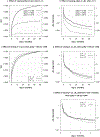Modeling Age Patterns of Under-5 Mortality: Results From a Log-Quadratic Model Applied to High-Quality Vital Registration Data
- PMID: 35040480
- PMCID: PMC8941647
- DOI: 10.1215/00703370-9709538
Modeling Age Patterns of Under-5 Mortality: Results From a Log-Quadratic Model Applied to High-Quality Vital Registration Data
Abstract
Information about how the risk of death varies with age within the 0-5 age range represents critical evidence for guiding health policy. This study proposes a new model for summarizing regularities about how under-5 mortality is distributed by detailed age. The model is based on a newly compiled database that contains under-5 mortality information by detailed age in countries with high-quality vital registration systems, covering a wide array of mortality levels and patterns. It uses a log-quadratic approach in predicting a full mortality schedule between ages 0 and 5 on the basis of only one or two parameters. With its larger number of age-groups, the proposed model offers greater flexibility than existing models in terms of both entry parameters and model outcomes. We present applications of this model for evaluating and correcting under-5 mortality information by detailed age in countries with problematic mortality data.
Keywords: Age patterns of mortality; Indirect methods; Model life tables; Neonatal mortality; Under-5 mortality.
Copyright © 2022 The Authors.
Figures







References
-
- Abdullah S, Adazu K, Masanja H, Diallo D, Hodgson A, Ilboudo-Sanogo E, . . . Binka FN (2007). Patterns of age-specific mortality in children in endemic areas of sub-Saharan Africa. American Journal of Tropical Medicine and Hygiene, 77(Suppl. 6), 99–105. - PubMed
-
- Agorastakis M, Jdanov D, & Grigoriev P (2017). About mortality data for Greece (Report). Available from https://www.mortality.org/hmd/GRC/InputDB/GRCcom.pdf
-
- Bourgeois-Pichat J (1951). La mesure de la mortalité infantile: I. Principes et méthodes [The measure-ment of infant mortality: I. Principles and methods]. Population (French Edition), 6, 233–248.
-
- Cantrelle P, & Leridon H (1971). Breast feeding, mortality in childhood and fertility in a rural zone of Senegal. Population Studies, 25, 505–533. - PubMed
Publication types
MeSH terms
Grants and funding
LinkOut - more resources
Full Text Sources
